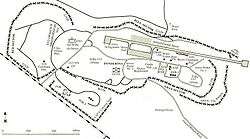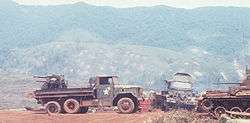Khe Sanh Combat Base
Khe Sanh Combat Base (also known as Ta Con) was a United States Marine Corps outpost south of the Vietnamese Demilitarized Zone (DMZ) used during the Vietnam War.
| Khe Sanh Combat Base | |
|---|---|
| 16°39′19.6″N 106°43′42.9″E | |
 Diagram of base | |
| Site history | |
| Built | 1962 |
| In use | 1962-1975 |
| Battles/wars | Vietnam War Battle of Khe Sanh Operation Lam Son 719 |
| Garrison information | |
| Occupants | 3rd Marine Division 1st Brigade, 5th Infantry Division |
History
In January 1966 the People's Army of Vietnam (PAVN) attacked the base with 120mm mortars and intelligence indicated that a PAVN buildup was taking place around the base. In March MACV instructed the III Marine Amphibious Force (III MAF) to plan a 1 battalion security operation around the base. On 27 March 3rd Marine Division commander MG Wood B. Kyle ordered the 4th Marine Regiment at Phu Bai Combat Base to deploy the 1st Battalion, 1st Marines and supporting artillery and mortar batteries to Khe Sanh. 1/1 Marines commander Lt. Col. Van D. Bell flew into Khe Sanh to plan his deployment and found the Special Forces there to be nervous and leaving all patrolling outside the perimeter to Nùng forces. On 3 April the operational order for Operation Virginia was issued, with the operation to begin on 5 April. On 4 April an advance unit was landed at Khe Sanh, but the arrival of the rest of the force was delayed by bad weather and the effects of the Buddhist Uprising and it wasn't until 18 April that VMGR-152 Lockheed Martin KC-130s were able to complete the deployment. The plan called for sequential sweeps to the northeast, northwest and then southwest of the base. On 19 April HMM-163 helicopters landed the headquarters unit and Company C in a blocking position 6 km north of the base and then landed Companies A and B 9 km further east, Companies A and B then swept west meeting no PAVN and joined up with Company C on 21 April and the force then returned to the base. Reconnaissance patrols of the northwest sector indicated no PAVN presence and so the 2nd phase of the operation was cancelled. III MAF then ordered 1/1 Marines to march east along Route 9 which had been closed for several years to determine if there was any PAVN buildup south of the DMZ. The artillery unit was moved to Ca Lu to cover Route 9 and on 1 May the 1/1 Marines completed the 30 miles (48 km) march from the base to Cam Lộ encountering no PAVN.[1]
Fighting began there in late April 1967 with the hill fights, which later expanded into the 1968 Battle of Khe Sanh. U.S. commanders hoped that the PAVN would attempt to repeat their famous victory at the Battle of Dien Bien Phu, which would permit the U.S. to wield enormous air power. Boeing B-52 Stratofortresses alone dropped more than 75,000 tons of bombs on the PAVN 304th and 325th Divisions encroaching the combat base in trenches.
On April 1, 1968, the U.S. Army's 1st Cavalry Division launched Operation Niagara to break the siege of the base. All three brigades from the 1st Cavalry participated in this vast airmobile operation, along with a Marine armor thrust.[2]
The defense of Khe Sanh commanded international attention and was considered the climactic phase of the Tet Offensive. On July 5, 1968, the combat base was abandoned, the U.S. Army citing the vulnerability of the base to dug-in enemy artillery positions in neutral Laos and the arrival of significant airmobile forces in I Corps (1st Cavalry and 101st Airborne Divisions). However, the closure permitted the 3rd Marine Division to conduct mobile operations along the DMZ.
In 1971, Khe Sanh was reactivated by the U.S. Army (Operation Dewey Canyon II) to support Operation Lam Son 719, the South Vietnamese invasion of Laos. It was abandoned again in early April 1971.[3][4] On the night of 23 March a PAVN sapper attack on Khe Sanh resulted in 3 Americans killed and several aircraft and 2 ammunition dumps destroyed, PAVN losses were 14 killed and 1 captured.[5]
On 27 January 1972 a U.S. Air Force Lockheed AC-130 gunship was shot down by a PAVN SA-2 missile over the base.[6] In March 1973, American intelligence reported that the PAVN had rebuilt the airstrip at Khe Sanh and were using it for courier flights into the South.
Tourism
Khe Sanh Combat Base can be visited daily as part of tours starting in Huế. Most of the base is now overgrown by wilderness or coffee and banana plants. In a small museum on base historical pictures and weapons are shown. Additionally a C-130, Boeing CH-47 Chinook, Bell UH-1 Iroquois, artillery and armor, restored bunkers and portions of the airstrip are visible.
Gallery
 Seabees of Mobile Construction Battalion (MCB) 301 set and seal runway mats into place at Khe Sanh, 29 November 1967
Seabees of Mobile Construction Battalion (MCB) 301 set and seal runway mats into place at Khe Sanh, 29 November 1967 Khe Sanh base, 1968
Khe Sanh base, 1968 Museum
Museum UH-1H helicopter
UH-1H helicopter CH-47 helicopter
CH-47 helicopter Outside view of a restored bunker
Outside view of a restored bunker The airstrip
The airstrip Khe Sanh landscape.
Khe Sanh landscape.
Fiction
The first person shooter Call of Duty: Black Ops features a level (titled SOG) where the player (fictional CIA operative Alex Mason) fights to defend Khe Sanh from the North Vietnamese Army.
The Electronic Arts/DICE game, Battlefield Vietnam (2004) features a level where the Khe Sanh base is the main base for US troops. The level incorporates other historical sites like Khe Sanh Village, Lang Vei, the junction of National Route 9 and Ho Chi Minh Highway, and the bridge over the Rao Quan River, though all of the interceding distances are compressed to work within the game's playable area.
See also
- Demilitarized Zone
- Khe Sanh
References
- Shulimson, Jack (1982). U.S. Marines in Vietnam: An Expanding War 1966. History and Museums Division, Headquarters, U.S. Marine Corps. pp. 140-3. ISBN 9781494285159.
- Lurps: A Ranger's Diary of Tet, Khe Sanh, A Shau, and Quang Tri, revised ed., Rowman & Littlefield Publishing Group, Lanham, MD (2009).
- DEPARTMENT OF THE ARMY - HEADQUARTERS - 8TH BATTALI0N (17MM/8 Inch) (SP), 4TH ARTILLERY, May 9th 1971
- Khe Sanh Medal of Honor Awards - HAGEN, LOREN D. - 1Lt, US Army, Inf, US Army Training Advisory Group.
- Fulghum, David; Maitland, Terrence (1984). The Vietnam Experience South Vietnam on Trial: Mid-1970–1972. Boston Publishing Company. p. 96. ISBN 0939526107.
- Melson, Charles (1991). U.S. Marines In Vietnam: The War That Would Not End, 1971-1973. History and Museums Division, Headquarters, U.S. Marine Corps. p. 32. ISBN 978-1482384055.